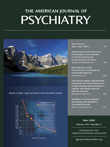Is Domestic Violence Followed by an Increased Risk of Psychiatric Disorders Among Women But Not Among Men? A Longitudinal Cohort Study
Abstract
Objective: The association between violence between intimate partners and psychiatric disorders is assumed to reflect a causal link. This assumption is now questioned because several longitudinal studies have documented that adolescents with psychiatric disorders grow up to be overrepresented among adults involved in partner violence. Method: The study followed a representative birth cohort prospectively. Adolescent mental disorders were diagnosed at age 18 years. Between ages 24 and 26 years, the authors identified individuals involved in nonabusive relationships versus those involved in clinically abusive relationships (i.e., resulting in injury and/or official intervention). At age 26 years, mental disorders were again diagnosed. Results: Male and female adolescents with psychiatric disorders were at greatest risk of becoming involved in abusive adult relationships. After the authors controlled for earlier psychiatric history, women who were involved in abusive relationships, but not men, had an increased risk of adult psychiatric morbidity. Conclusions: 1) Psychiatric disorders pose risk for involvement in abusive relationships for both sexes; 2) partner abuse is a contributing source of psychiatric disorders among women but not among men.



